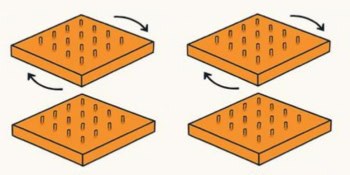It has been a good week for nanoscience and technology with three major developments being reported. Physicists in the US have built a microscopic transistor that contains a "bouncing" carbon-60 molecule. The device could have important applications in nanotechnology. Meanwhile another team of scientists from the US has discovered that carbon nanotubes could prove to be the best heat conductors known to man. Finally, researchers in Germany and the US have succeeded in producing a spherical carbon molecule containing just 20 atoms. This is the smallest possible "fullerene", as these carbon molecules are called.
Whereas the carbon atoms in a graphite sheet are arranged in hexagons, the fullerene form of carbon includes both pentagons and hexagons. The first fullerene to be discovered, carbon-60, contains 12 pentagons and 20 hexagons and is shaped like a football. Now Paul McEuen’s group at the Lawrence Berkeley National Laboratory and the University of California at Berkeley has fabricated a single-molecule transistor based on a carbon-60 molecule bouncing between gold electrodes (H Park et al. 2000 Nature 407 57).
The transistor uses a process known as vibration-assisted tunnelling. For current to flow through the transistor, electrons must tunnel across the gaps between the carbon-60 molecule and the electrodes. To tunnel onto the molecule, an electron in the source electrode must have precisely the correct energy to occupy the lowest energy level in the molecule. However, if the electron has extra energy that is equivalent to the vibrational energy of carbon-60, it can still tunnel onto the molecule by using this surplus energy to set the molecule in motion.
The Berkeley team believe that, under certain conditions, a single electron is transferred between the electrodes during each cycle of the carbon-60 oscillation. Since the frequency of the vibration is quantized, it follows that the current flowing through the transistor is also under tight control. The device, in effect, acts like an “electron turnstile”. This control could be used to measure electric currents with extreme accuracy.
Carbon nanotubes are made by rolling up sheets of graphite to create hollow cylinders of pure carbon. These nanotubes have remarkable properties: they are incredibly strong and can behave either as semiconductors or conductors. Now Alan Johnson of the University of Pennsylvania and co-workers have discovered that nanotubes also conduct heat extremely well (J Hone et al. 2000 Science 289 1730). The heat is conducted by low-energy phonons, which can be thought of as quanta of sound waves. The electrical properties of nanotubes have been extensively investigated and found to be consistent with the electrons being confined to the one dimension of the tube. However, similar confinement of phonons has not been observed until now.
The results also show that the remarkable heat conduction properties of nanotubes extend to larger “bundles” of tubes. The bonds between individual nanotubes are extremely weak, so the phonons do not scatter into adjacent tubes. Unfortunately, this weak bonding between tubes also means that “ropes” formed from the nanotubes are likely to be relatively weak.
Finally, Horst Prinzbach and co-workers at Albert-Ludwigs-University in Freiburg, Germany and Boston College in the US have produced minute quantities of the smallest possible fullerene, carbon-20 (H Prinzbach et al. 2000 Nature 407 60). The molecule, which consists of 12 pentagonal rings, was previously thought to be too unstable to exist. Prinzbach and co-workers have created both the fullerene form of carbon-20 and a bowl-shaped isomer which may improve our understanding of how fullerenes form.



